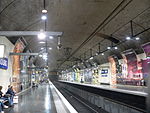Medici Fountain
Buildings and structures in the 6th arrondissement of ParisFountains in ParisFrench Renaissance

The Medici Fountain (French: la fontaine Médicis) is a monumental fountain in the Jardin du Luxembourg in the 6th arrondissement in Paris. It was built in about 1630 by Marie de' Medici, the widow of King Henry IV of France and regent of King Louis XIII of France. It was moved to its present location and extensively rebuilt in 1864-66.
Excerpt from the Wikipedia article Medici Fountain (License: CC BY-SA 3.0, Authors, Images).Medici Fountain
Rue de Fleurus, Paris Quartier de l'Odéon (Paris)
Geographical coordinates (GPS) Address Phone number Website Nearby Places Show on map
Geographical coordinates (GPS)
| Latitude | Longitude |
|---|---|
| N 48.848055555556 ° | E 2.3391666666667 ° |
Address
Jardin du Luxembourg
Rue de Fleurus
75006 Paris, Quartier de l'Odéon (Paris)
Ile-de-France, France
Open on Google Maps









